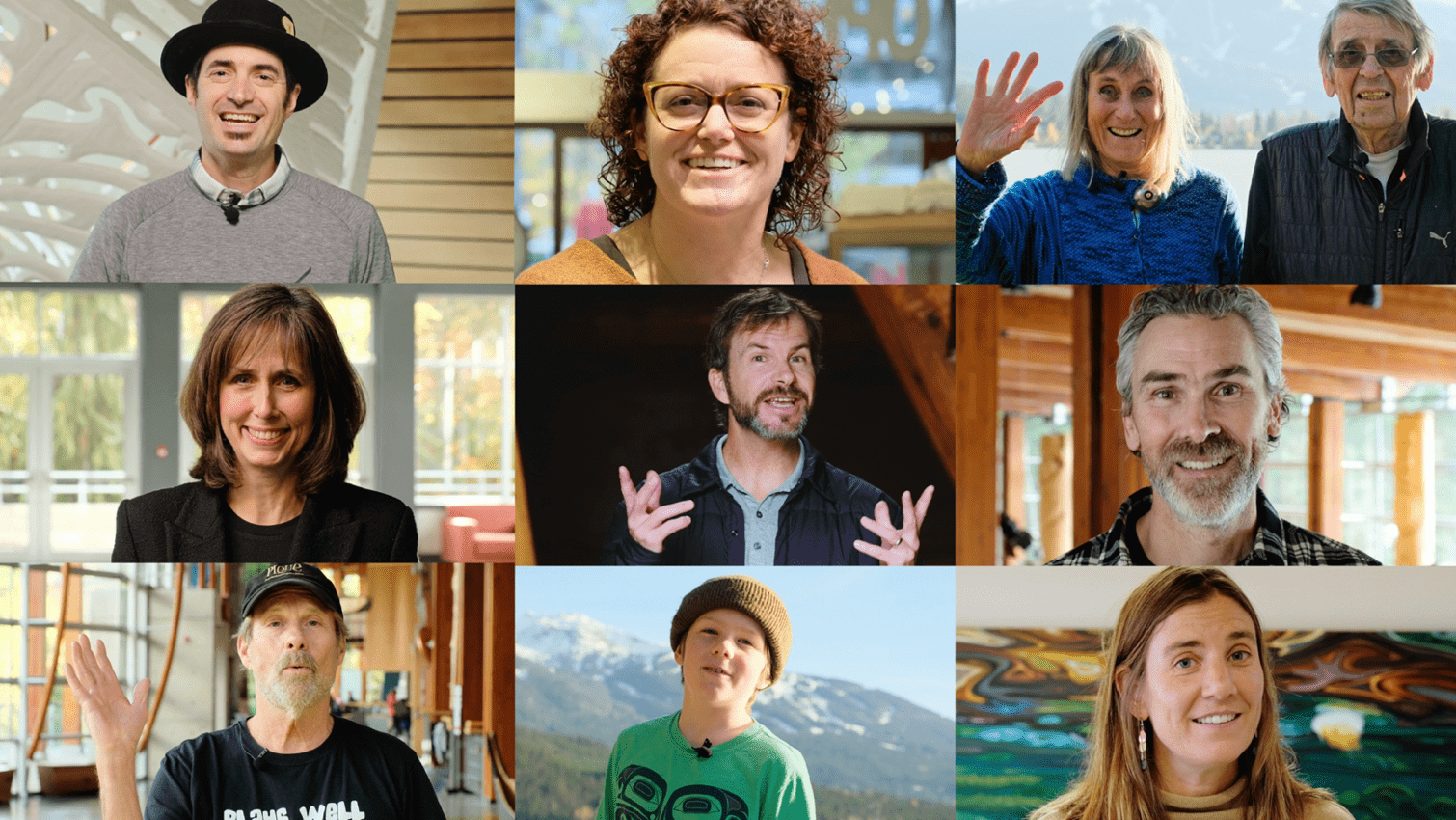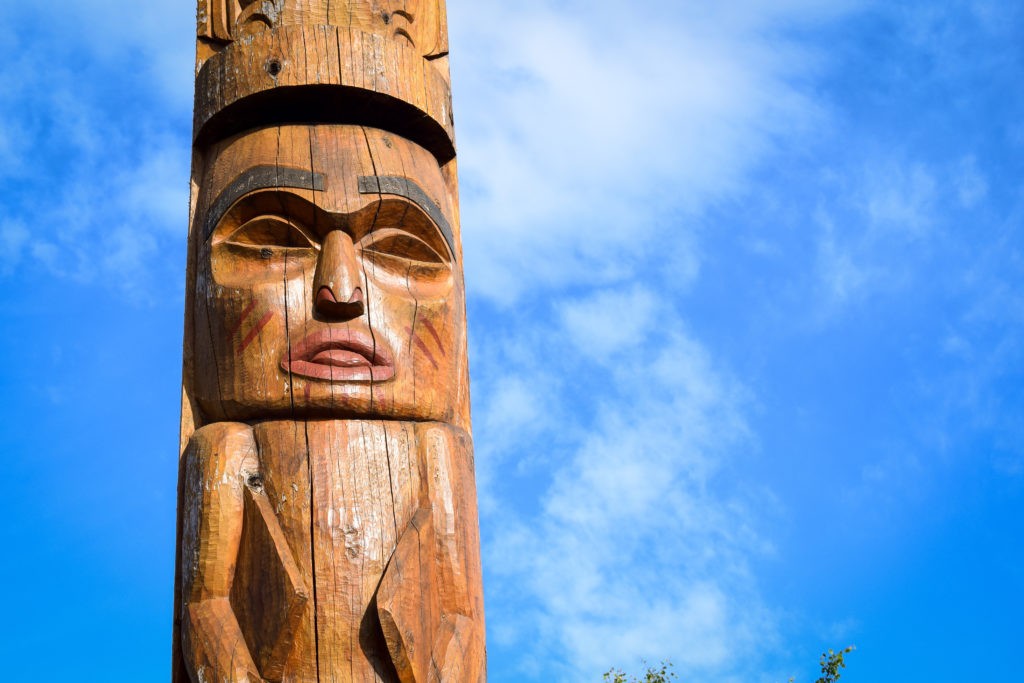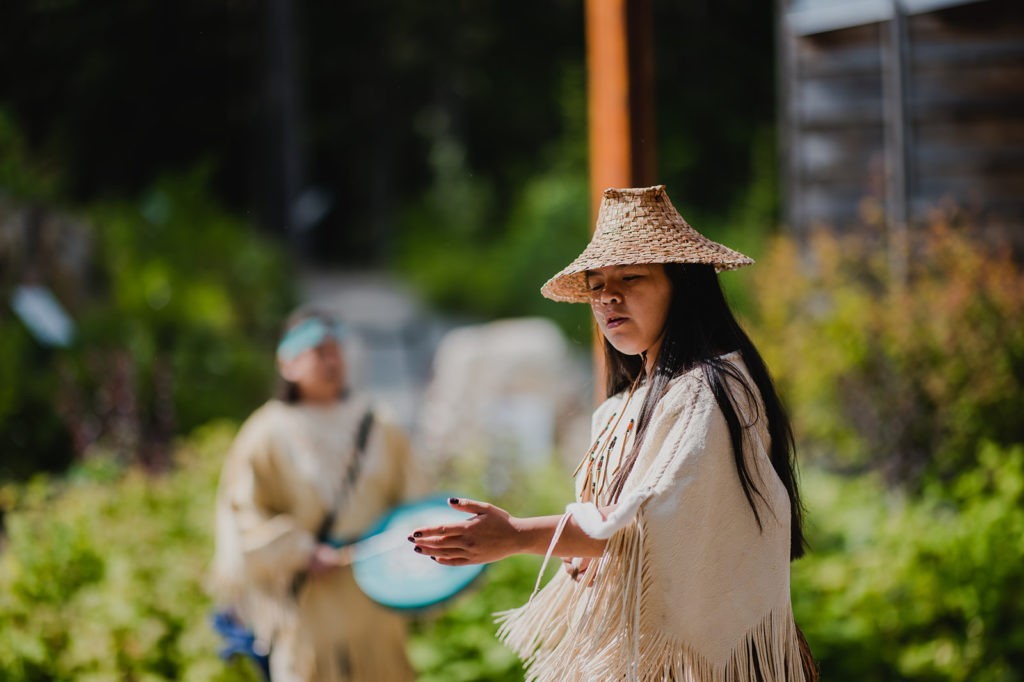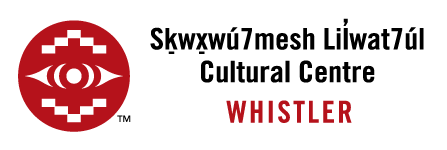
25 Jan Hey Whistler: Let’s talk about Land Acknowledgements
Alternative title: The First Step.
What are you doing right now? Reading this blog at home on your couch? At work? In a lunchroom or cafe? On a chairlift? In a park? Are you sitting on a bench along one of Whistler’s serene trails? Perhaps you’re in the ístken pithouse, tucked away at the corner of Lorimer Road and Blackcomb Way, inhaling the cleansing cedar smell, and embracing the silence. Whatever you are doing right now, if you are in Whistler you’re doing it on the shared unceded territory of the Squamish Nation and Lil’wat Nation.

When I started working at the Squamish Lil’wat Cultural Centre in March, the pandemic descended upon on us all, and the world logged into Zoom, speaking in boxed up spaces like a community version of Hollywood Squares. Something struck me in those early days of isolation: as meetings and events started moving online, how Land Acknowledgements have evolved from their passionate well-intended roots in Truth and Reconciliation, into a Roberts Rules of Order requirement that is checked off the to-do list as fast as a board approving the minutes of their last meeting.
There is so much good when Land Acknowledgements are heard at meetings and read at the end of email signatures. They can be a passionate, personal statement and a fundamental shift in how we as a society, business, or community connect to this land. Part of how we get there is by understanding and connecting to the words and purpose behind a Land Acknowledgement.
It is important to note that everything written here is not coming from me as a scholar on the subject. I am not Indigenous; I work for an Indigenous organization. The content found here has been gleaned from the life changing experience this job has given me, the Indigenous people I have had the privilege to listen to and read, the world I have witnessed through changed eyes, and the community I live in: one that has looked towards the SLCC for guidance and inspiration.
What are Land Acknowledgements?
Land Acknowledgements are a necessary first step in recognizing, with historical accuracy, the original peoples of this land. Highlighted bold, underlined, sent with fireworks, in capitals, put-it-on-a-billboard: FIRST STEP.
Why did the SLCC create a Land Acknowledgement video?
To inspire passion and understanding about the land we work, live, learn, and play on. To ignite meaning and action in the words we speak.
I am in Whistler and need to say a land acknowledgement at an upcoming meeting/event/etc.,. What do I say?
… But the whole point of this page is that you don’t just copy/paste the sentence below, then go on with your day!
Simple version
I am grateful that this meeting is taking place on the unceded shared territory of the Squamish Nation and Lil’wat Nation.
To reiterate… We encourage you to not just copy/paste the sentence below, but instead take the time to read and connect meaningfully with your acknowledgement. There are so many wonderful, respectful, and authentic versions included on this page.
Hey, there’s not much diversity in the video. Why is it all white people?
Good question. Why are so many of Whistler’s leaders and influencers white? Why isn’t there representation on our local council or leadership teams? While we’re at it.. Why am I, a white girl with Irish and Scottish roots, the Executive Director of a First Nations museum and cultural centre? These are all great questions for us as a community to dig in and ask ourselves. Solving that question, and confronting with love and empathy any other truths or questions that come up as a result of asking it, is a pretty decent Second Step.
This short video was filmed and produced by a local black photographer and filmmaker, Ryan Robinson. We spoke at length about putting more diversity into the video, including Ryan himself. The more we designed it, the more we were faced with the same question – Is Whistler diverse? We realized that by purposefully seeking a person of colour for the video, the SLCC would be doing the same thing that so many other organizations do: getting representation in production when it is not consistently there in reality. If we did it, I would have had to admit to myself the intention behind the request, and provide our diversity star with a nice shirt, and the word “TOKEN” in large font printed across the chest.
‘Tokenism’ is what we are trying to tackle by creating this video. We seek an evolution from stale, recited Land Acknowledgements that for some Indigenous people feel like a token effort – as if they are being crossed off the to do list.
Say Land Acknowledgments with passion! Know why you are saying it. Don’t be afraid of making a mistake! Learn from it! Look steadfast in the eyes of your audience and mean these words: Whistler is on the shared unceded territory of the Squamish Nation and Lil’wat Nation. Avoid reading it like a script, and please try not to visibly put a check mark on your notes after it is said.
The consideration and acknowledgement of the land and the Indigenous people’s rightful place, leadership, and stewardship of this land is a promise in every design and decision made, to consider the needs, impact, and representation of the people who once thrived here; whose ancestors are buried here. Because, the work we do, the recreation we enjoy – your heart rate raising or meditative gazing – is happening on the shared unceded territory of the Squamish Nation and Lil’wat Nation.
Why aren’t Indigenous people in the video saying the acknowledgement?
During Whistler events, at their choosing, SLCC Ambassadors will welcome participants to the land. People who are not of the Nations whose territory they are on will say the land acknowledgement.
Best practice: the Indigenous group sharing or extending a Welcome are the first to speak, even before the host or emcee. Right after the Welcome is complete, the host acknowledges the land and territory they are on. Personally, when hosting an event or meeting, I have tried to replace the word “Welcome” with a “Hello!”

Worth mentioning: SLCC Ambassadors are present for many events, meetings and ceremonies. You can find out more here. If you are hosting an online event, the SLCC has also produced a Welcome video you may be able to use. Send your enquiry to info@slcc.ca
Who is in the video and why haven’t you credited them?
This is something we pondered on. Land Acknowledgements can sometimes serve as an opportunity to remove personal power that position or privilege may have had a part in getting us to this point. In its place they bring humility, curiosity, and Indigenous consideration to the proceedings. It was decided that the SLCC would make a video focusing on the purpose and not the necessarily the participants (who we deeply appreciate and welcome into our group of friends, advocates, allies, and partners in this journey).
Here they are in order of appearance: Jack Crompton, Barrett Fisher, Brandi and Luke Woodnut, Trevor Linden, Cst Kelly Dean, Cpl Nathan Miller, GD Maxwell, Geoff Buchheister, Trudy and Peter Aldder, Dana Friesen Smith, Diana Chan, Tracy Hutton, Mike Douglas, Ginny Cullen, Jeanette Bruce, Brad Nichols, and (my bias-fueled personal favourite) Colt Paul.
What about “Traditional” Territory?
A traditional territory is the geographic area identified by a First Nation as the land they and/or their ancestors traditionally occupied and used. Adding or removing the word ‘traditional’ from land acknowledgements is an important conversation taking place right now. The word ‘traditional’ sometimes takes on connotations like ‘historical’, or ‘originally’, with many people and organizations moving away from using the word. Perhaps this was the intent when Land Acknowledgements were created: starting something that has the purpose of actioning good changes. Look at the ‘traditional’ land acknowledgement as a first step: where the words are open to actively evolve as we gain a better understanding of the truth, and reconcile our own relationship with Indigenous people.
You may notice that the word ‘traditional’ is used in our Land Acknowledgement video. The Squamish Lil’wat Cultural Centre recognizes that everyone is starting from a different place of learning, and we want to meet you there, focusing on compassion and education. The video also tries to highlight the word ‘territory’ by repeating it, in an effort to eclipse a word we think may be nearing its end of life in Canada’s Land Acknowledgements.
I heard that some Indigenous people don’t even like Land Acknowledgements
Yes, that’s true. Maybe for some they have too often been present when Land Acknowledgments are said without good intent or action. How many times have you heard a Land Acknowledgement recited like a necessity (‘check that box’), perhaps not moving beyond the First Step?
Okay, I got it! Second Step: get Indigenous representation on my board/staff/etc.
You don’t have to be Indigenous to start considering Indigenous people. A fundamental change in our own thinking can be part of this second step. Indigenous people have been speaking up and documenting their experience for centuries. Large beautiful buildings have been erected in celebration of their history (psst.. there’s one in Whistler that is considered a national gem and an unprecedented experience). Formline stories told on Welcome Figures and other carvings. Books written. Blogs Blogged. Talks recorded. Truths revealed. I am often asked “How do we get Indigenous people to the table?”. Well, first let’s look at the table.
Some tables may need a culture shift that goes far beyond the constraints of this Blog. Some of us will dive deep into unlearning what we have been taught in the past. Maybe all of us will see with great clarity every root, droplet, branch and breath behind the Indigenous experience. It’s about knowing the history and understanding the value of Indigenous wisdom and practices. It is introspective work that creates pause in yourself with every strategy or question at the helm, and I am unable to type anything further, because I am still learning. I am still following my second step, only a few dusty specs ahead of my first.
With Land Acknowledgements, when you understand deeply why you are saying the words, you will ignite the power of authenticity behind them. They exist with the sincerest hope that words create. Create action. Change. Understanding.
I can share my journey, but am not a teacher. There are so many books written by powerful Indigenous voices: Taking Back the Indian Act, Unsettling the Settler Within, and 21 Things You May Not Know About the Indian Act, just to name a few.
In addition, some web and workshop resources:
Decolonize Everything (includes Land Acknowledgement workshops!)
M̓i tel’nexw Leadership Society
https://native-land.ca/resources/territory-acknowledgement/
https://www.ictinc.ca/blog/inclusive-worksite-for-indigenous-worker
Whistler 101: Indigenous Peoples
Who is doing it right? Anyone trying.
At the end of this page I’ve shared some examples of Land acknowledgements, lifted off the emails, gatherings and meetings of our local business community and allies.
In conclusion, there is no conclusion
Okay, I hope for a day where there is indeed a conclusion. That the euro-centric system is broken down and a new one of many parts and perspectives is built up in its place. But, as my panic riddled brain can tell you in that the moment when I realized we will be long dead before this is solved: we have to start our change and keep it moving. Be part of something that will grow as generations grow. The First Step is the learning you put into your passionate and well-meaning Land Acknowledgement.
The Second Step is to take a second step.
Unpack diversity and tokenism. Read and research (The SLCC gift shop, Whistler Public Library, and local book stores have lots of reading material!). Design your journey towards Truth and Reconciliation. Look inward at what prejudices you have, and love yourself deeply, knowing this is not a flaw in you, but perhaps in the system that raised you. Promote and support Indigenous businesses and artists. Become a member of the SLCC, or your own local Indigenous cultural centre or museum – Go! Learn! Get to know the staff! Pick up and use some traditional language! Talk about Indigenous history at dinner tables! Speak up! Share! With enthusiasm and great passion!
The Squamish and Lil’wat people were on this land before settlers or pioneers. Sk̲wx̲wú7mesh Úxumixw in English is the people of the Squamish villages (there was no word for Nation). L̓il̓wat7úl are the real or true Lil’wat, they adopted this name when newcomers came into their territory and mistook them for their cousins that live around Lillooet, BC. The ancestors of the Ambassadors you meet here at the SLCC lived, hunted and traded on this land for time immemorial. The Wallace family, also known as the Wolf Clan, fished in Fitzsimmons River, just behind the SLCC. A descendent of the Wolf Clan, Maggie Wallace, is a Red Seal Chef student at our Thunderbird Café, and works steps away from her ancestors nourishing, living, land.
And my final plea for accuracy: Whistler Mountain was not “originally” known as London Mountain. It was originally known as Cwítima/Kacwítima (Lil’wat), and Sk̲wik̲w (Squamish).
When you start using Land Acknowledgements, when you say the words and put them on your emails and letterhead, you become part of a living purpose: Land Acknowledgements have the power to recognize truth, and reclaim what colonial history books and systematic government regulated genocide took away, opening the door for possibility and change.
Huy Chexw (thank you) Wa Chexw Yuu (take care) – Squamish Language
Kukw`stumc`kalap (Thank-you all) – Lil’wat Language,
Heather Paul
Executive Director, Squamish Lil’wat Cultural Centre
Start writing your own Land Acknowledgement
The Basics
Simple version
I am grateful that this meeting is taking place on the shared unceded territory of the Squamish Nation and Lil’wat Nation.
The meaning behind these words and the order in which they appear can help form a deeper understanding of this place:
| shared | On March 22, 2001 the Sk̲wx̲u7mesh Úxumixw (Squamish) and L̓il̓wat7úl (Lil’wat) signed a historic protocol. They formally agree once again to live and work together in Whistler, BC. This is why the word ‘shared’ is used when describing the territory known as Whistler. The protocol agreement between the two Nations is unprecedented and the first of its kind in Canada. |
| unceded | Unceded means that First Nations people never ceded or legally signed away their lands to the Crown or to Canada. |
| territory of the Squamish Nation and Lil’wat Nation | So much to unpack here. To find out more, visit he SLCC, watch Whistler’s Indigenous 101 |
| BONUS TIP: | Please don’t say “Squamish and Lil’wat Nation”. They are two distinct Nations with their own language and history |
Some Examples from Whistler’s Local Businesses
“Arts Whistler conducts its work on the unceded, traditional territory of the Squamish Nation and Lil’wat Nation. We respectfully honour their cultures and traditions.” – Arts Whistler
“We gratefully and respectfully acknowledge that our workplace, the land now known as Whistler, lies in the unceded territory of the Sk̲wx̲wú7mesh and Líl̓wat Nations.” – Zero Ceiling
“With respect and gratitude, we operate on the shared unceded territory of the Skwxwú7mesh (Squamish) and Lil̓wat7úl (Lil’wat) Nations.” – Moguls Coffee House & Zogs
“We gratefully and respectfully acknowledge that the Whistler Blackcomb Foundation operates on the unceded territory of the Sk̲wx̲wú7mesh and Líl̓wat Nations.” – Whistler Blackcomb Foundation
Online meeting with people outside of Whistler?
We would like to begin by acknowledging that we are fortunate to conduct this meeting on the shared unceded territory of the Squamish Nation and Lil’wat Nation. I recognize there are people in virtual attendance who are working and living on the territories of other Nations, and respectfully acknowledge the land they are joining us from.
Remember: You don’t have to let the stress of perfection force you to read blankly from a page. Be authentic, and learn from mistakes.


Peggy English
Posted at 15:30h, 21 FebruaryHi Heather: this is an outstanding article that I not only enjoyed but also learned from it. Isn’t that the measure of a good article? I think so; thank you for this,
I have been searching and have not been able to find out if the Squamish Nation or the Lil’wat Nation had names for the lakes in the Whistler region:. They are now called Alpha, Nita, Alta, Lost and Green. They sound like “Euro-creation” names to me. Is there anywhere or anyone who would remember their real/original names?
Again, thanks for all your work as we all continue to learn and appreciate each other.
Douglas Millar
Posted at 17:33h, 02 JuneThis blog entry is an excellent deconstruction of the Land Acknowledgement and a thoughtful discussion. Thank you!
Hayley Cianca
Posted at 11:43h, 14 NovemberThank you for this well written, informative and helpful article.